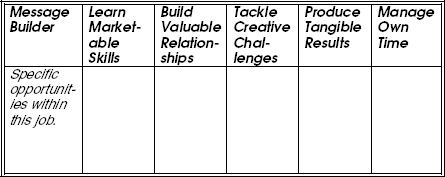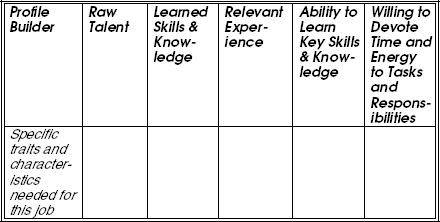2.
Recruiting and Selecting
the Stars of Generation X
There are four key elements to recruiting and selecting the stars of Generation X: (1) Creating a profile of the ideal applicant for the position to be filled; (2) Developing a recruiting message which will be effective in attracting applicants who meet that profile; (3) Selecting the person most suitable for the job from among all the applicants; and (4) Ensuring that the applicant selected is given an accurate preview of the day-to-day experience of the job he or she is being hired to do.
(1) Profiling the ideal applicant. There are several factors to look for in an applicant for any job: Raw talent, learned skills and knowledge, relevant work experience, ability to learn the kinds of skills and knowledge necessary to do the job, and willingness to devote substantial time and energy to the tasks and responsibilities of the job. In order to profile the ideal candidate, use each of these categories to identify the particular traits and characteristics necessary to the particular job in question.
(2) Developing an effective recruiting message. Xers are looking for several key factors in a job: Opportunities to learn marketable skills, to build relationships with people who can help them, to tackle creative challenges, to produce tangible results and collect proof of their ability to add value in any workplace, and to manage as much of their own time as possible. In order to build the right message to attract the best applicants, use these categories to inventory the opportunities held within the particular job you have to offer.

(3) Selecting the most suitable person. Once you have attracted several ideal applicants, the challenge is to select the most suitable person for the job in question. In order to do so, you will need to use some of the traditional techniques such as reviewing resumes and cover letters, conducting interviews, and checking references.
In order to select the best Generation Xers, you will also need to put aside some obsolete assumptions. For example, it is no longer wise to dismiss an applicant merely because he or she seems to be a “job-hopper”—someone who has not held any one job for more than one or two years. This is no longer an indication of someone who is unable to get along and contribute in the workplace, but rather may indicate someone who has unique skills and is able to apply those skills on short-term projects to meet immediate and ephemeral needs. Such an employee may be very valuable in today’s economy of uncertain markets and unpredictable staffing needs.
Let me suggest two important strategies which will tell you a great deal about whether or not the applicant is the kind of day-to-day value adder you need: (i) Ask for free samples of tangible results accomplished by the applicant in prior experiences (make sure you have some way to verify that the tangible results were in fact achieved by the applicant); and (ii) Ask the applicant to submit a written proposal describing exactly how he or she would apply his or her skills to meet a specific need in your organization.
(4) Providing an accurate job preview. One of the most common causes of voluntary turnover is when new employees find out that the job they were hired to do is not exactly what they envisioned when they applied. The best remedy is to make sure that, once you have selected the person who seems to be most suitable for the job, you provide that person with an accurate preview of the actual day-to-day experience of accomplishing the tasks and responsibilities of the job. Let me suggest five approaches to providing an accurate job preview: (i) Offer the applicant you wish to select the opportunity to “tag along” with another person in your organization who is doing the same (or similar) job. By tagging along for several days, a week, or more, your applicant will get a good picture of what the job actually entails. (ii) Produce a videotape of someone in your organization performing the key tasks and responsibilities of the job and provide an opportunity to view the tape. (iii) Create a written (and illustrated) document instead of a videotape to achieve similar results at a lower cost and provide the applicant with a chance to thoroughly review the written document. (iv) Engage the applicant in a very frank discussion describing the specific details of the key tasks and responsibilities of doing the job. (v) Let the applicant engage in frank discussions with several people who are actually doing the job and instruct them to be painfully honest about the low points as well as the high points of the experience.

